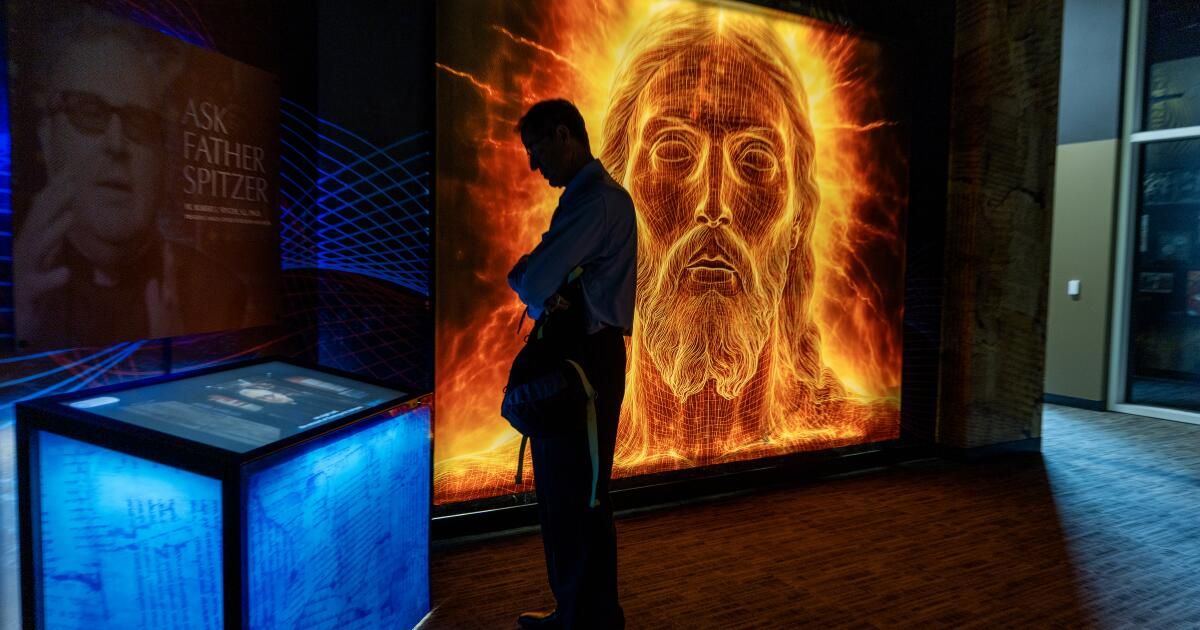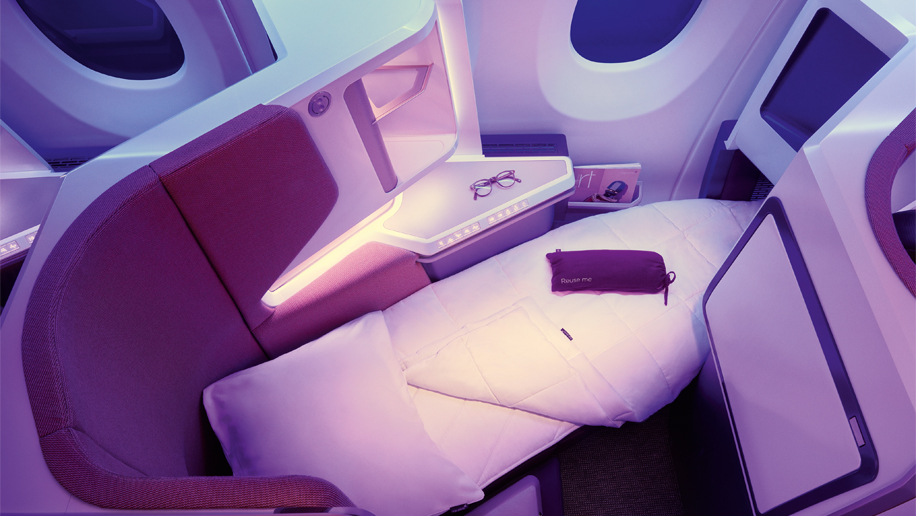On the second floor of a cultural center at Christ Cathedral in Orange County, a calm, smiling AI-rendered depiction of Jesus fills one side of the room. Breaking a piece of flatbread in two, he passes it to the 12 similarly sized men projected on the four walls around him. On the floor there are images of plates full of food: roast lamb, vegetables, olives and sauces.
“Take and eat,” says AI Jesus. “This is my body.”
In the center of the room, real-life visitors, arranged in 26 swivel chairs, turn their heads back and forth to watch the oversized Last Supper occurring around them. They have already been immersed in the Sea of Galilee watching Jesus walk on water and witness his transfiguration on a mountaintop. It was all part of what is billed as “a museum like no other, where faith and forensic science meet.”
Visitors watch an AI-rendered 360-degree video depicting the life of Jesus as told in the Gospels at the opening of the Shroud of Turin Experience at Christ Cathedral.
(Allen J. Schaben/Los Angeles Times)
Located five miles from Disneyland on the campus that once housed televangelist Robert Schuller's Crystal Cathedral Ministries, the Shroud of Turin is Orange County's newest tourist attraction with a Christian twist. The 10,000-square-foot exhibit, which opened to the public last week, uses digital projection, artificial intelligence and special effects to introduce visitors to the life of Jesus as described in the Gospels, focusing on the mysterious linen cloth that believers say wrapped his body after the crucifixion.
“It's a little Disney-esque, but we really want you to feel like you're in these scenes,” said Pat Powers, a financial advisor who helped raise money for the exhibit. “We want the whole experience to be visually overwhelming.”
Driven by technological advances and consumers' desire to connect in person, immersive experiences are revitalizing the way businesses and organizations connect with new audiences, and the Catholic Church has taken note. From the viral hit Van Gogh: The Immersive Experience, which arrived in Los Angeles in 2021, to the 360-degree entertainment at Sphere in Las Vegas, young people in particular are looking for new and dynamic ways to interact with their entertainment. Now, as the Catholic Church seeks to connect with a new generation of Christians who may not be familiar with the biblical Jesus and the mystery of the Shroud, religious and lay leaders are exploring digitally enhanced ways to bring people to faith.

An interactive display on the Shroud of Turin allows visitors to zoom in on the details of the Shroud of Turin, a mysterious linen cloth that some believe covered Jesus after his death.
(Allen J. Schaben/Los Angeles Times)
“We want to talk to people the way they're used to being talked to today and in a way they can absorb,” Powers said.
Organizers said the desire to equip the exhibit with digital bells and whistles came directly from the top. The Diocese of Orange only agreed to approve the privately funded project after organizers promised it would offer interactive elements beyond text and images.
“I said no static images, too boring,” said Bishop Timothy Freyer, auxiliary bishop of the diocese. “Posters on the walls weren't going to cut it.”
Now, billboards around Christ Cathedral's 34-acre campus where the Diocese of Orange is located advertise “The Shroud of Turin Experience” as if it were a summer blockbuster: “Discover the blood. Discover the mystery. Find the light.”
Approximately 14 feet long and three feet wide, the Shroud of Turin is one of the most scientifically studied and controversial religious objects in the world: a sacred relic to some and others. medieval forgery to others. Marked by burns and water stains, the narrow linen sheet features hundreds of blood stains consistent with the wounds Jesus suffered at the time of his death. Even more mysteriously, it shows the faint image of a bearded man that some Christians believe provides physical evidence of Jesus' resurrection. The Catholic Church has not taken an official position on the veracity of the Shroud, but exhibition organizers find the evidence of its divine provenance compelling and hope others will too.

A bronze statue of Jesus stands in front of an enlarged negative image of the facial detail on the Shroud of Turin.
(Allen J. Schaben/Los Angeles Times)
“Our position is that the shroud offers evidence of the resurrection, but not proof,” said Nora Creech, a shroud scholar who helped organize the exhibit. “The goal is to guide people and let them follow their own journey.”
Visitors will not be able to see the Shroud of Turin. It has not left its former home, the Cathedral of St. John the Baptist in Turin, Italy, for centuries. However, with the blessing of the Bishop of Turin, the organizers were able to obtain a life-size, high-resolution replica. Exhibit docents will show visitors how to change the camera settings on their iPhone to create what looks like a photographic negative, making it easier to see the shadowy figure on the canvas.
“Kids always think that's cool,” Creech said.
The exhibit costs $20 for adults, and organizers say visitors should allow at least 90 minutes to tour it. In the first of three immersive rooms, a dizzying 360-degree video presents visitors with the story of Jesus' life from his baptism to the crucifixion, including that gigantic Last Supper. At the end of the 20-minute film, a projected rock moves away from a door leading to a second room designed to resemble Jesus' tomb, with a prone figure lying on a stone altar, wrapped in a white cloth. There guests watch an 18-minute documentary detailing scientific research into the Shroud before moving to a third “chapel” room where an AI-animated video shares Bible stories about sightings of Jesus after his death.

Customers see a large image of Christ on the cross.
(Allen J. Schaben/Los Angeles Times)
The second half of the exhibition is more traditional. Visitors can examine various instruments of torture that were reportedly used to inflict pain on Jesus, including replicas of the nails used for crucifixion, the crown of thorns that adorned his head, and the double-edged blade of a Roman spear that pierced his side. Interactive features include a kiosk that digitally separates each level of the shroud so visitors can examine just the blood stains, just the burn marks, or just the shadow image. Those who want a truly deep dive into the shroud can interact with a virtual Father Spitzer, president of the Magis Center on Reason and Faith and local expert on the shroud, to hear pre-recorded answers to questions such as “What evidence suggests that a supernatural cause was necessary for the formulation of the image on the shroud” and “How do neutrons explain the shroud's exceptional resistance to aging and solvents?”
The final room of the exhibition is designed for reflection and includes a life-size bronze statue of Jesus created by Italian artist Luigi Enzo Matte, according to the dimensions of the image on the shroud.
Although there is a clear religious bent to the entire experience, Creech said the exhibit, which is expected to remain at Christ Cathedral until at least 2030, is designed to share information about the life of Jesus and the shroud, but not necessarily to convert anyone.
“I think we can convince people that the shroud is the shroud that wrapped the physical body of Jesus,” he said. “But Jesus emphasizes the importance of believing. Proclaiming that Jesus is our lord and savior is an act of faith that each must take on their own.”












